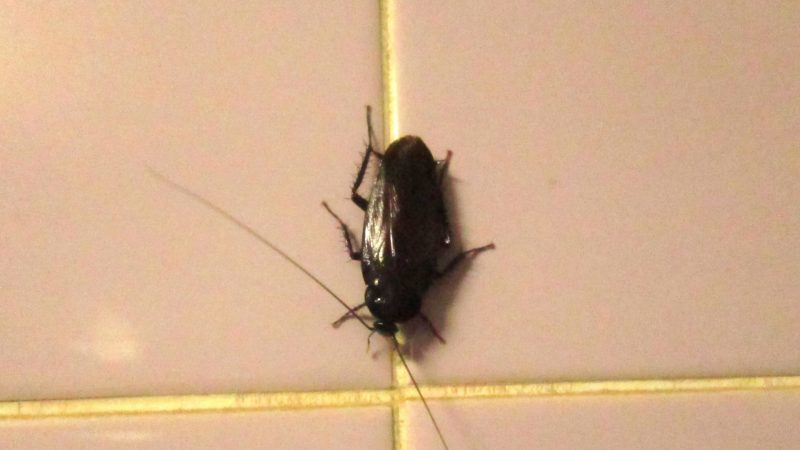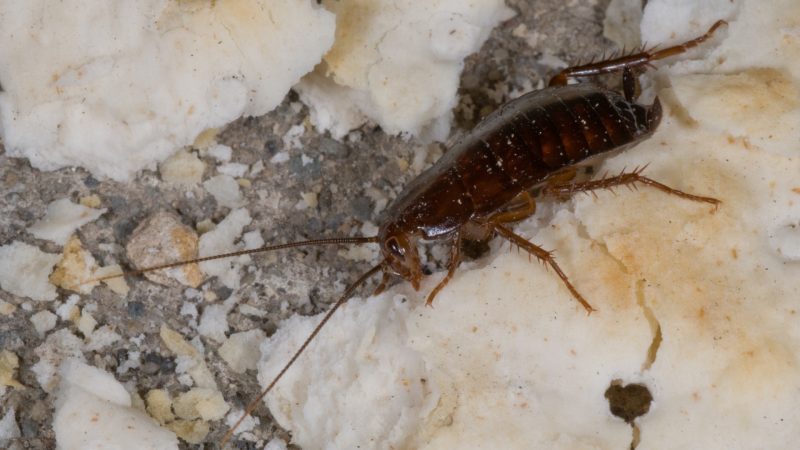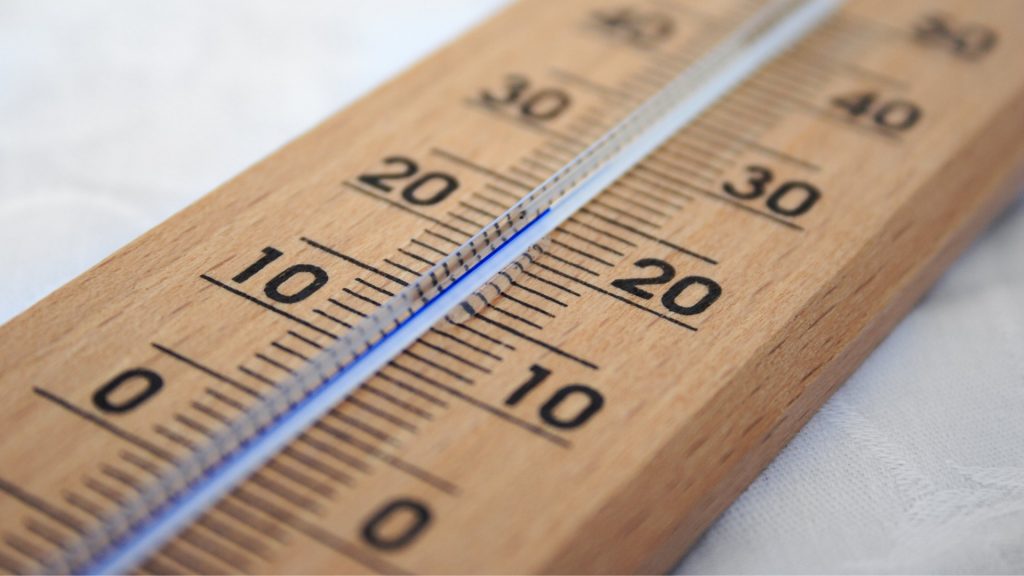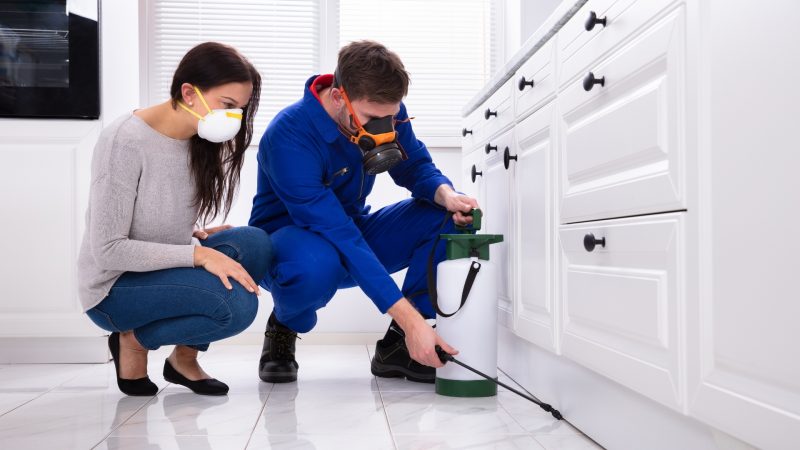The oriental cockroaches are one of the largest cockroach species in the world. They are also known under other names, such as “waterbugs” or “black beetle cockroaches”.
Their usual place used for hiding is any damp area they can find. Like other cockroach species, they can get inside your home in many different ways. For example, they can enter under doors, through holes, or by following leaking pipes and drains.
Are oriental cockroaches harmful? Oriental cockroaches are one of the more dangerous pests to have in your home. The oriental cockroaches are able to carry around different parasites, viruses, and bacteria on their bodies. Because of this, they can easily contaminate your living area and cause serious diseases. Especially if they get in touch with your food, you can easily catch intestinal diseases like diarrhea, salmonella, or even dysentery.
These pests can also bite people, but it usually occurs only when the infestation is quite severe. Their skin sheddings, body parts, or feces can trigger asthma, especially in younger children.
Seeing a cockroach in your home is never a pleasant sight. Adult oriental roaches can grow up to 1 inch in length. They have smooth, black bodies and wings, but neither males nor females can fly. Also, people with oriental roach infestation usually complain about the strong, very unpleasant odor they emit.
Through the rest of this article, you’ll be introduced to this dangerous species. The better you understand a certain pest, the easier it will be to eliminate it from your premises. The elimination process can take time, but your home will become a healthy and safe environment once again. Let’s begin!
Related: How to Get Rid of Oriental Cockroaches | Effective Removal Techniques and Prevention Tips
What Is an Oriental Cockroach? | Information
Where Are Oriental Cockroaches Found?
Oriental cockroaches are primarily outdoor species, meaning they have adapted to live and survive in nature. Their ideal habitat is leaf litter, space beneath debris or stones outdoors. If they infest your home, their shelter is usually around drains and sewers.

Preferable living conditions for oriental roaches are cool and humid locations, so they are pretty common in basements and cellars. Toilets, sinks, pipes, and bathtubs provide ideal living conditions for them. They are very dependent on water and usually choose lower floors.
How Did the Oriental Cockroach Get Its Name?
The name “oriental cockroach” comes from trade ships, but their real origin is in Africa. Ships carried them to other parts of the world, and nowadays they are one of the most common cockroach species. These pests are considered to be one of the dirtiest species, and the only one that prefers cooler temperatures.
Is an Oriental Cockroach Known as a Water Bug?
Water bug is another name for this cockroach species, at least that is what many people call them. They got the name because of their need for water. One study showed that this cockroach species can survive without food for months, but without water only for two weeks.
Related: Natural Ways to Get Rid of Waterbugs | Effective and Eco-Friendly Methods
They choose dark and damp areas, especially where the temperature is a little bit lower. Outside they are usually found in yards, beneath leaves and stones. Oriental roaches are also common around places where trash containers are placed.
In your home, you may find them under the sink, washing machines, or in a basement. They can travel through pipes and drains and consequently infest your home.
What Is the Life Cycle of an Oriental Cockroach?
An adult female Oriental cockroach produces around eight egg capsules during its life. Every capsule contains around 16 eggs placed in a vertical line, two by two in the egg case. They carry the capsule for a few days until they find the right place to deposit the capsule. That is usually a safe, warm, and sheltered environment.
The incubation period varies, from 42 to 81 days on average. When a female oriental cockroach deposits and leaves the egg case, the young/nymphs are left alone, without any assistance. Nymphs pass through seven molts before they become adults. Their transformation lasts about a year. An adult can live from 34 to 180 days.
What Is the Scientific Name for Oriental Cockroach?
Blatta orientalis is the scientific name for an oriental cockroach. It’s one of the most common species up there with German cockroaches. No country in the world is free of its presence.
What Do Oriental Cockroaches Look Like?
The oriental cockroach is recognizable by its dark brown color and shiny black body. They can grow to about 1 inch in length, but males are usually smaller than females. Both males and females have wings but females have smaller wing pads, and neither one of them has developed the ability to fly.
Males have more developed wings that cover most of the body, leaving only the last few abdominal segments exposed. Females have wing pads that cover and shelter only the first segments of the body.
Are Oriental Cockroaches a Problem?

Can Oriental Cockroaches Bite?
Oriental cockroaches can bite, but they will rarely bite people. If it happens, you’ll have a clear sign that there is a severe infestation of oriental cockroaches in your home.
A large population can have difficulty finding food inside your home, so the hunt is going to happen even during the day. If you get bitten, there is a high possibility that you won’t even notice the bite mark. Their bite for humans is small and painless.
Do Oriental Cockroaches Make Noises?
Normally, oriental cockroaches don’t make sounds. However, under certain circumstances, they can produce some type of sound, especially while mating. Any strange sound that you hear which comes from a place you think roaches found a shelter you should take seriously! It takes a very large population and a severe infestation to make noise.
Do Oriental Cockroaches Have Bacteria?
Roaches can be dangerous to humans due to the large number of viruses, bacteria, and parasites that they carry around on their bodies and feces. As roaches choose unsanitary areas for living, it’s no wonder they can cause serious health problems.
If bacteria in any way ends up in our food, we can easily ingest it and get intestinal problems. Food poisoning, diarrhea, and stomach ache are only a few options from so many other possible intestinal diseases.
Can Oriental Cockroaches Make You Sick?
Harmful germs are all over oriental cockroaches’ bodies and feces and can easily get to you and seriously harm your health! Usually, people get sick by ingesting food that was contaminated by cockroaches’ feces or simply crawling over it, which helps with the transition of dangerous bacteria and parasites.
Once germs enter your body, the symptoms start. Food poisoning can lead to vomiting, diarrhea, and even high fever. Many intestinal problems can occur along with allergies. As roaches shed skin, parts of their body, and feces they can trigger allergies and asthma.
Do Oriental Cockroaches Infest Homes?

How Do You Get Oriental Cockroaches in Your Home?
Oriental cockroaches prefer areas with plenty of moisture, but also places that are dark and with enough shelter to hide, breed, and develop. They usually travel through pipes, drains, and sewers. They can also hide inside of them. Another way to get them inside your home is to bring them accidentally on your clothes, shoes, and grocery bags.
There are so many possibilities, but the main thing that’s going to decide if the roaches are staying and infesting your home is the living conditions they find inside. If there is a lot of food, water, and hiding areas, you’ll be dealing with a roach infestation problem for a while.
Where Do Oriental Cockroaches Live?
Can Oriental Cockroaches Live in a Well?
Oriental cockroaches can definitely live inside of the well. As unbelievable as it may sound, they can. Wells can provide moisture, food, and shelter. It is also a very cool and dark place, which are the ideal living conditions for oriental roaches.
Can Oriental Cockroaches Live Outside?
Oriental cockroaches are outdoor-oriented species, although still very common inside of homes. They usually infest gardens during the summer months. Ideal living conditions for them provide damp areas with cooler temperatures. Outside they are often found in sewers, leaf piles, mulch, under rocks, and stones.
Can Oriental Cockroaches Survive in Water?
Many roach species prefer to live in circumstances where plenty of water is available, but only a few of them can survive in water for a longer period. Oriental cockroaches can survive in water for up to 40 minutes.
They don’t breathe through the mouth. Oxygen gets inside their bodies through small holes called spiracles. Survival for more than half an hour means that you won’t get rid of them by flushing them through the sink and drains.
Where Do Oriental Cockroaches Come From?
Can Oriental Cockroaches Come Out of Toilets?
Oriental cockroaches cannot swim through water, they can only float. It means that toilets are not one of the ways for them to enter your home but on the other hand, ideal conditions provide the sink, drains, and pipes. As roaches feed on basically anything they find, an ideal source of food is nothing more than sludge stuck in the sink.
Do Oriental Cockroaches Come up Through Faucet?

If oriental cockroaches inhabit the pipes, then yes, they can come up through the faucet. This usually means that the infestation you are dealing with is quite severe. If you live in a building, roaches infesting your pipes can be a little bit more difficult to solve.
If all of your neighbors don’t take the problem seriously and participate in solving it, you may be facing the return of roaches in no time. They can hide easily and travel through pipes from one apartment to another.
When Do Oriental Cockroaches Come Out?
Oriental cockroaches, like other roach species, are nocturnal pests. There is a higher possibility to spot them during the night when they leave their shelters and start searching for food.
If you spot them in your home during the daytime, it can mean only one thing: the population infesting your home is getting out of control. Lack of food will make them hunt for food during the day.
What Attracts Oriental Cockroaches?
Are Oriental Cockroaches Attracted to Light?
Oriental cockroaches are not attracted to light. They don’t like it at all. Being nocturnal hunters, they hide from the light. They search for dark and hidden areas as they suit their needs the best. Dark, humid areas with or near food attract all types of roaches.
Do Oriental Cockroaches Prefer Sweets?
An oriental cockroach can feed on literally anything edible, which is one of the main reasons why they are such strong survivors. They can adapt to any situation and use the food other animals and humans eat. It’s no surprise for them to consume waste and materials like soap and toothpaste.
If they had to choose, oriental cockroaches would definitely opt for sugary foods! Sweets, starches, and fruits are their favorite! That’s why you should keep in mind that any leftovers, even spilled sugar on the floor and crumbs, can be the reason roaches stay in your home.
What Temperature Do Oriental Cockroaches Prefer?

Oriental roaches prefer cooler temperatures anywhere from 65 °F to 85 °F. They usually infest homes during the summer months but prefer to stay on lover floors, near ground and water. Hiding in the dark and cool spaces is something they do outdoors too.
How Do Oriental Cockroaches Reproduce?
Do Oriental Cockroaches Breed Inside Homes?
Oriental cockroaches are heavy breeders, which makes them dangerous to have in your home. They can quickly develop a large population if you don’t react to the first signs as soon as you notice them. They use their shelters for breeding, and egg cases can be placed almost anywhere.
It’s a bad thing for your home, as roaches, along with egg cases are full of bacteria and germs. If an egg case ends up on your food, you can get food poisoning, diarrhea, salmonella, and other intestinal problems.
How Fast Do Oriental Cockroaches Reproduce?
A female roach carries a capsule that contains eggs from around twelve hours to five days. This period depends on finding the right place to leave the egg capsule.
Each egg case contains up to sixteen eggs. The female does not take part in caring for the offspring. After the egg case is placed somewhere safe, it takes up to two months for the eggs to hatch. For the full development of the nymphs, the required time is about twelve months. One female cockroach can create up to eight capsules during its lifetime.
How Many Eggs Do Oriental Cockroaches Lay?
One female oriental cockroach can lay around 16 eggs per egg case. The period needed for the eggs to develop into nymphs is about two months.
When Do Oriental Cockroaches Lay Eggs?
Breeding and laying eggs is not connected to a season. However, the development of the eggs is. It is easier for them to develop during the warmer months.
Where Do Oriental Cockroaches Lay Eggs?
A female oriental cockroach carrying an egg case can spend up to five days searching for the best shelter to place it. The chosen space has to be warm and near water, not to mention well-protected. After finding the place, the female abandons the eggs and plays no role in further development.
How to Kill Oriental Cockroach?

For survival, Oriental cockroaches need water, food, and a hiding spot. By eliminating all these things, you will eliminate the infestation. Because this topic of pest control is a little bit extensive and requires a step-by-step process, we have prepared a separate article for it.
If you are interested, click on the following link, and you will get our step-by-step guide for getting rid of oriental cockroaches with recommended products.
How to Keep Oriental Cockroaches Out of My House?
Once you are done with an oriental cockroach infestation, or you just want to prevent their appearance in your home, you have to keep in mind a few things and set some rules.
First, use caulk to seal any small holes, gaps, or cracks that roaches can use to enter your home. Be careful, especially around doors and windows.
Next, fix your plumbing installations. Any old, leaking pipes should be replaced. Eliminate the sludge from the sink and drains. Water should pass through them without any obstacles.
Keep your home clean by setting a regular cleaning routine. Vacuum at least once a week, clean your floors and try not to leave any stains on the floor. Never keep dirty dishes for hours in the sink. Any food leftovers should end up in the trash before you leave the kitchen at night.
Your food should be kept in closed, sealed packages and boxes to prevent roaches from easily accessing it.
Keep your basement clean and humid-free, as oriental cockroaches simply adore the conditions basements provide. Ventilation is very important here as well. You can also use a dehumidifier to keep the moisture away.
Keep all of your trash away from your home’s foundation. If you can, use a mesh screen over your windows and vents.
Summary
Oriental cockroaches are very common pests and can easily become a daily problem you will have to deal with. They can feed on almost anything. It’s a myth that only dirty homes attract roaches. They can infest clean areas as well, as roaches can be brought inside by accident on a grocery bag, shoes, clothes, etc. Cockroaches can even come inside through open doors and windows.
Food, water, and shelter are the main things that attract oriental cockroaches. Dark and cooler places suit them best, so you can usually spot them inside basements or bathrooms. If you spot any signs of roach infestation, you should act quickly! Leave no time for them to breed and grow their population.
List of Sources
McCanless K., Oriental Cockroach, University of Florida
Oriental Cockroach, Department of Entomology at Texas A&M University
Cockroaches, Vanderburgh County Health Department
- How to Get Rid of Cockroaches? | Proven Strategies & Solutions! - June 24, 2023
- Powerful Homemade Wasp and Bee Sprays (with Recipes) - March 4, 2023
- Crazy Ants Invasion | Eradicate & Prevent Unwanted Guests - February 24, 2023
